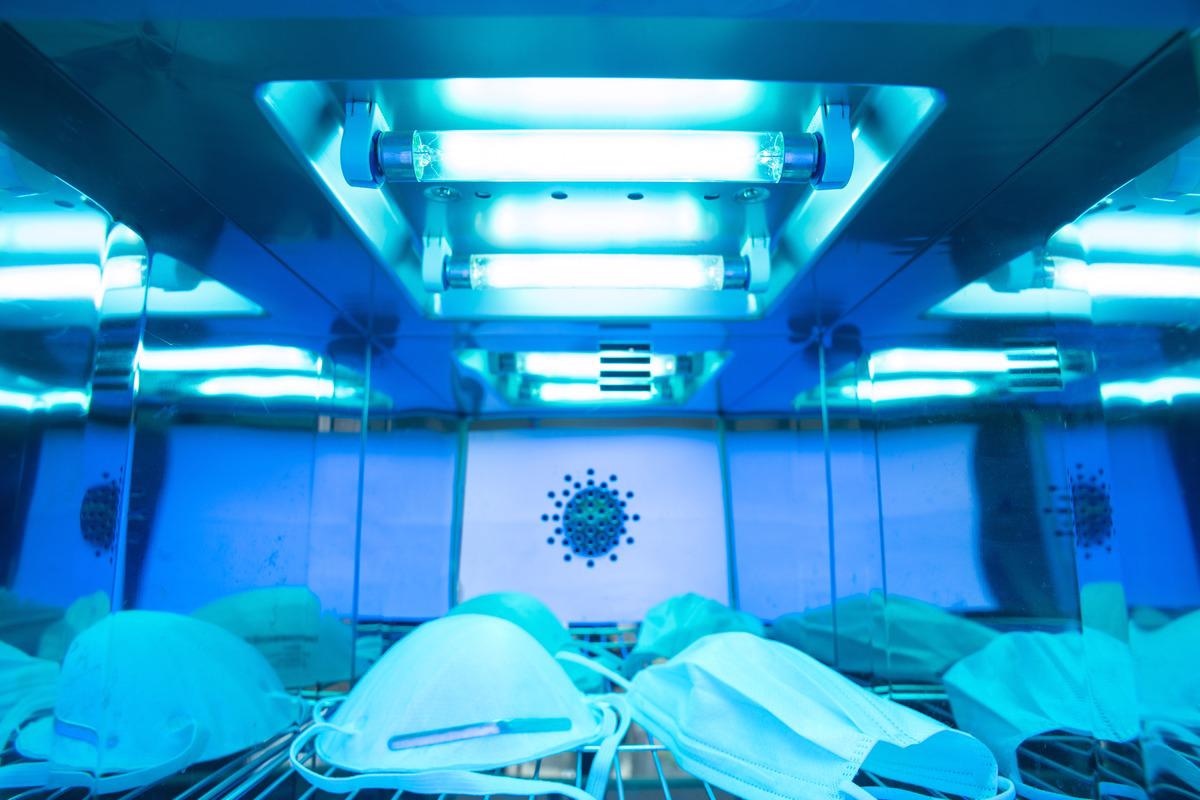In a recent paper posted to the bioRxiv* preprint server, researchers showed that 425 nm blue light can inactivate all major severe acute respiratory syndrome coronavirus 2 (SARS‑CoV‑2) variants.
They demonstrated that at twice-daily dosing, 425 nm light inhibited Beta and Delta variant replication in a three-dimensional human tracheobronchial epithelial model.
 Study: Visible blue light inactivates SARS-CoV-2 variants and inhibits Delta replication in differentiated human airway epithelia. Image Credit: Nor Gal/Shutterstock
Study: Visible blue light inactivates SARS-CoV-2 variants and inhibits Delta replication in differentiated human airway epithelia. Image Credit: Nor Gal/Shutterstock
The emergence of new and more infectious SARS-CoV-2 variants with the capability to evade host immune responses has resulted in massive surges in coronavirus disease 2019 (COVID-19) cases worldwide thus prolonging the pandemic. Although several vaccines have been developed to prevent COVID-19 infection and severity, additional countermeasures are needed to return to the pre-pandemic normal.

 *Important notice: bioRxiv publishes preliminary scientific reports that are not peer-reviewed and, therefore, should not be regarded as conclusive, guide clinical practice/health-related behavior, or treated as established information.
*Important notice: bioRxiv publishes preliminary scientific reports that are not peer-reviewed and, therefore, should not be regarded as conclusive, guide clinical practice/health-related behavior, or treated as established information.
Thus, the development of an effective, variant-agnostic therapy option for treating early SARS-CoV-2 infection is crucial to decrease the global healthcare and economic burden caused by this pandemic.
Previous studies have reported on the effectiveness of visible 425 nm light in the treatment of mild-to-moderate COVID-19 by targeting the light on the oropharynx and surrounding tissues. However, the efficacy of targeted blue light against new SARS-CoV-2 variants of concern has not yet been established.
About the study
In the present study, researchers showed that 425 nm visible blue light effectively inactivated SARS-CoV-2 variants in a well-differentiated model of the large airway in humans.
The researchers obtained Vero E6 and A549 cells and SARS-CoV-2 parental strain WA1 and Alpha, Beta, Delta, Gamma, Lambda, and Omicron isolates for the study. They used MatTek EpiAirwayTM large airway epithelial models and primary human tissue models derived from large human airway epithelial cells.
A plaque assay was used to determine infectious SARS-CoV-2 viral titers. The monoclonal antibody Bamlanivimab was used to prepare serial dilutions of virus-antibody combinations that were incubated and then titered using plaque assay. The team counted plaques for each antibody dilution and virus input and determined the 50% and 90% neutralization cut-off based on the virus input.
Using the plaque reduction neutralization tests (PRNT), the researchers evaluated whether the same 425 nm light doses inactivated various SARS-CoV-2 variants such as Alpha, Beta, Delta, Gamma, Lambda, and Omicron. Enzyme-linked immunosorbent assay (ELISA) was used to examine illuminated samples for angiotensin-converting enzyme 2 (ACE2) binding, and quantitative polymerase chain reaction (qPCR) was used to detect SARS-CoV-2 ribonucleic acid (RNA).
Results
The results showed that 425 nm light specifically inactivated the Alpha, Beta, Delta, Gamma, Lambda, and Omicron variants by nearly 99.99% and the effect was dose dependent. In contrast, bamlanivimab a monoclonal antibody failed to neutralize the SARS-CoV-2 Beta, Delta, and Gamma variants. When they compared the 50% plaque reduction (PRNT50) and 90% plaque reduction (PRNT90) titers for bamlanivimab and 425 nm light, they found that the PRNT50 and PRNT90 titers for bamlanivimab for the Beta, Delta, and Gamma variants were more than 128-fold higher than that for WA1.
In contrast, the PRNT50 and PRNT90 doses for blue light were similar for WA1 as well as the Alpha, Beta, Delta, Gamma, Lambda, and Omicron variants, indicating that all SARS-CoV-2 variants tested are equally susceptible to inactivation by 425 nm light.
Since no inactivation of the human adenovirus (a non-enveloped DNA virus) or the human rhinovirus (an RNA virus) was observed, the team concluded that blue light does not damage viral DNA or RNA and its inactivation mechanism was envelope-dependent.
The researchers also observed that 425 nm light inhibited the binding of the virus to the host ACE2 receptor and blocked in vitro viral entry into the host cells. Also, when the light application was started during early infection, the administration of 32 J/cm2 425 nm light twice daily for three days decreased infectious Beta and Delta variants by greater than 99.99% in human airway models. Using the same dosing plan in established, late-stage infections, the team observed logarithmic reductions of infectious Beta and Delta titers.
Conclusion
The researchers of this study had previously demonstrated the safety and therapeutic efficacy of blue light against WA1; however, several new variants with potential for immune escape have emerged since and replaced the parental strain. In this study, they demonstrated the inactivation of SARS-CoV-2 variants using light showing that the new mutations in these variants do not confer resistance to blue light inactivation.
The study results showed that the visible blue light in the 425 nm dosing regimen was well tolerated in the large human airway model. The findings demonstrate the potential of blue light therapy as a safe and variant-agnostic therapeutic option against COVID-19 by controlling acute SARS-CoV-2 infections and reducing viral load and symptomatic disease.

 *Important notice: bioRxiv publishes preliminary scientific reports that are not peer-reviewed and, therefore, should not be regarded as conclusive, guide clinical practice/health-related behavior, or treated as established information.
*Important notice: bioRxiv publishes preliminary scientific reports that are not peer-reviewed and, therefore, should not be regarded as conclusive, guide clinical practice/health-related behavior, or treated as established information.
Journal reference:
- Preliminary scientific report.
Jacob Kocher, Leslee Arwood, Rachel C. Roberts, Ibrahim Henson, Abigail Annas, David Emerson, Nathan Stasko, M. Leslie Fulcher, Marisa Brotton, Scott H. Randell, Adam S. Cockrell.(2022). Visible blue light inactivates SARS-CoV-2 variants and inhibits Delta replication in differentiated human airway epithelia. bioRxiv. doi: https://doi.org/10.1101/2022.01.25.477616 https://www.biorxiv.org/content/10.1101/2022.01.25.477616v1